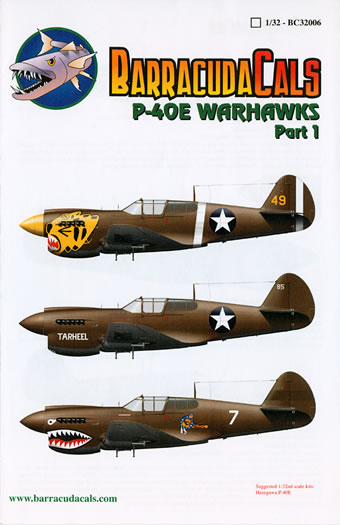P-40E Warhawks
Part 1

BarracudaCals, 1/32 scale
Summary |
Catalogue Number: |
BarracudaCals BC32006 - P-40E Warhawks Part 1 |
Scale: |
1/32 scale |
Contents and Media: |
Decal sheet, full colour instruction sheet in a resealable bag. |
Price: |
USD $13.95
available online from BARRACUDAcals website
also available online from Hannants and Sprue Brothers |
Review Type: |
FirstLook |
Advantages: |
Informative instruction sheet, high quality decals in perfect register, thin carrier film and a compliment of stencil data. |
Disadvantages: |
|
Conclusion: |
First rate decals and first rate support material at a reasonable price all which has got to make them value for money |
Reviewed by Rodger Kelly

HyperScale is proudly supported by Squadron.com
More new decals from Roy Sutherland’s company BarracudaCals.
Sticking with the P-40 theme, this sheet – BC32006, provides markings for three
P-40E “Warhawks” of the United States Army Air Forces (USAAF) from three different theatres in the early years of World War Two.
The individual options are:
- Curtiss P-40E Warhawk of the 343rd Fighter Group, who were based in the Aleutian chain of islands, Alaska, in the spring of 1943. The machine is in the then standard camouflage scheme for USAAF aircraft of olive drab over neutral grey and features the “tigers head” marking on the nose (hence the Group’s name of “Aleutian Tigers”), a yellow spinner, white fuselage band (command stripe?), a white vertical stripe on its rudder and yellow 49 “plane in squadron number” as well as large U.S. ARMY on the lower surfaces of the wings.
- Lieutenant George Preddy’s Curtiss P-40E Warhawk “Tarheel” The then 2nd Lieutenant George Preddy flew this machine in the skies of Darwin, in the far north of Australia in February of 1942 when it was assigned to 9th Fighter Squadron, 49th Fighter group. The machine is in the olive drab over neutral grey camouflage scheme and features the name “Tarheel” in white on the port side of the engine cowling, a fire breathing green dragon on the right hand side of the cowling, numerals “85” plane in squadron number on the front of the cowling and on both sides of the vertical stabiliser as well as large U.S. ARMY on the lower surfaces of the wings. Interestingly, the very mangled remains of this aircraft and the one it collided with during a training exercise on 12 July 1942 can be still be seen today lying on a ridge to the north west of the Manton Reservoir.
- Colonel Robert L. Scott’s Curtiss P-40E Warhawk “The Old Exterminator” when he was the Commanding Officer of 23rd Fighter Group in Kunming, China, in early October 1942. This option is in the same camouflage scheme as the previous ones and features a fearsome shark mouth and eyes markings on its nose, “Flying Tiger” insignia on ether sides of the fuselage, Japanese flag “kill markings” on the left hand side beneath the cockpit, white 7 plane in squadron numbers on the either side of the fuselage and large U.S. ARMY on the lower surfaces of the wings.
The decals themselves have been printed by Cartograf. The white and yellow portions of the markings appear to be dense enough to survive application over a dark background and there is a minimum of carrier film surrounding each subject. The detail of the printing is a joy to behold with everything on Scott’s intricate Flying Tiger insignia and Preddy’s dragon markings in perfect register. You get a single set of national insignia and two very comprehensive sets of stencil data – the stencil data even extends to the placards that were applied to the cockpit interior. You get two sheets in this issue, a normal sized main that carries all of the markings and stencil data as well as a smaller one that carries the large U.S. Army marking.
The placement guide is A-4 in size and folded in half to give you four sheets that carry full colour left hand side profiles of each option on one sheet, full colour upper surface views of each option on the next and left and right hand side, and upper and lower surface line drawings to show placement of stencil data. The fourth page forms the “cover”. A further half A-4 size sheet is also included and this sheet carries detailed instructions on how to apply the decals.
The placement guide carries detailed notes for each option as well as paint matches to the Model Master and Polly Scale ranges of model paints.
The recommended kit is the Hasegawa P-40E.
The placement guide, application instructions and three decal sheets come packed in the industry standard clear plastic zip-loc bag.
Nitpicks? Nope, not with this one apart from the fact that they are only released in 1/48 scale but I’m sure that BarracudaCals will bow to pressure from fans of other scales and eventually release them in 1/48 and 1/72 scale.
My impressions of this sheet are the same as they were for their other P-40 sheet - first rate decals and first rate support material at a reasonable price all which has got to make them value for money as far as I am concerned.
Thanks to BarracudaCals for the samples
BarracudaCals decals are
available online from their website
Text and Images Copyright © 2009 by Rodger Kelly
This Page Created on 16 June, 2009
Last updated
22 June, 2009
Back to
HyperScale Main Page |
